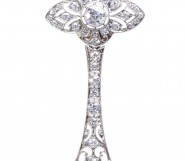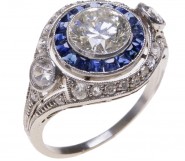Lot #85 - Frederick (Fred) Ronald Williams
-
Auction House:Mossgreen
-
Sale Name:The Estate of Ann Lewis AO
-
Sale Date:07 Nov 2011 ~ 6pm
-
Lot #:85
-
Lot Description:Frederick (Fred) Ronald Williams
(1927–1982, Australia, United Kingdom)
Fred Williams is widely considered Australia's greatest and most singular landscape painter. His reputation as an artist germinated in the 1940's and
Oil on canvas
134 x 152cm
Signed and dated ’65 lower centre -
Provenance:Sotheby's Australia, Important Australian Art, Melbourne, 27/08/2007, Lot No. 16
-
Notes:Fred Williams is widely considered Australia's greatest and most singular landscape painter. His reputation as an artist germinated in the 1940's and 1950's, but it was during the 1960's that some of his most important works would be realised. In particular the landscapes around the You-Yangs and Upwey in Victoria, where the artist and his family lived in a small bungalow, stand out as tours de force in Australian painting. Hillside I stands today as one of the artists most amazing works and it is rightly included in the current retrospective at the National Gallery of Australia. Williams always had a great interest in the construction of a painting, learning much from his early tutors at art school in Melbourne. George Bell and William Dargie taught him construction and artistic discipline and Max Meldrum influenced him greatly on tonality. In this majestic landscape, the artist has set himself a most difficult challenge, both in terms of perspective and in form. The steep vertical horizon line is perhaps his most daring re-interpretation of a traditional Australian landscape and for its time would have appeared a most extraordinary painting. Indeed looking at it today in contemporary terms, it is still a very modern work and very relevant. The related work - Hillside 1963/4 - was completed before the artist's trip to Europe in 1964 and this work also has an unusual horizon line, although in this case the horizon line is curved. Having won the Helena Rubenstein Travelling Scholarship the year prior, the artist and his wife Lyn set off in 1965 on what was to be a most important travel experience. Having recently been signed up by the legendary Sydney art dealer - Rudy Komon, the artist was at a very crucial moment of his artistic life. While in Europe he was greatly inspired by what he saw from Renaissance art in churches and museums across Europe. He was also particularly taken with aspects of European painting that he saw first hand. Artists such as Gustave Courbet influenced his paint technique and Honoré-Victorin Daumier in particular influenced his use of light and dark and horizons. Others less obvious such as Piet Mondrian influenced how he would construct and de-construct his own paintings. Back home in Australia his own connections with the George Bell circle artists such as John Brack, Danila Vassilief, Peter Purves-Smith and Ian Fairweather also had their influence on the artist. On observing Hillside I close up, you can see clearly the 'Scumbling' technique to the left hand section of the work that accentuates the dry earthiness of the sun parched ground, as if recently brushed with a broom. There is an extreme feeling of unease and tension that is caused by the severe angles, both of the horizon line and also with the trees that jut out at different angles, which at first sight seem quite awkward. But when you examine the work more closely and as a whole, everything in the picture is necessary, even the distinctive horizontal lines that possibly represent tracks, seem to underline the potential hazard of falling rocks. Despite the overall effect being challenging, the landscape is alive and vital. As a whole the picture is resolved and beautiful. Even the artists own signature, in bold scripted form, is blended into the landscape and forms a base-line horizontal. The extraordinary sky tone of peachy cream blends into the landscape through the use of prominent trees and streaks in the sky. Without them, the whole right hand pane and its colour might appear incongruous and unfinished. The rich earthy tones of the ground are punctuated with flashes of red light which appear like firelights. The scuffed teal-blue and white dabs of glutenous paint relieve the flat browns, creating a landscape that dances with life. Despite the lack of any figures or animals the work communicates the Australian bush environment to us brilliantly, despite its uncompromising vista. The almost square window in which we view this landscape adds further to the one third versus two thirds effect and the two parts complement each other seamlessly, almost like a Yin and Yang symbol. The construction of this picture is based on symmetry, but as in great Japanese Art, there is also a balance of asymmetry. The work is built in oils on canvas, materials that the artist could now afford with the recent success of being signed to Rudy Komon's gallery. The artist grew to love working on canvas and in this painting you can see how the scratchy dusty patchwork of the earth and the matt sky on an overcast day, are accentuated by the texture of the canvas on which they are applied. This love of paint and painting the landscape which is at the very essence of the artist is summed up in the following quote: I see things in terms of paint, all else is irrelevant. Fred Williams. More - see Mossgreen's original printed catalogue.
-
Estimate:A$1,000,000 - 1,500,000
-
Realised Price:
-
Category:Art
This Sale has been held and this item is no longer available. Details are provided for information purposes only.










